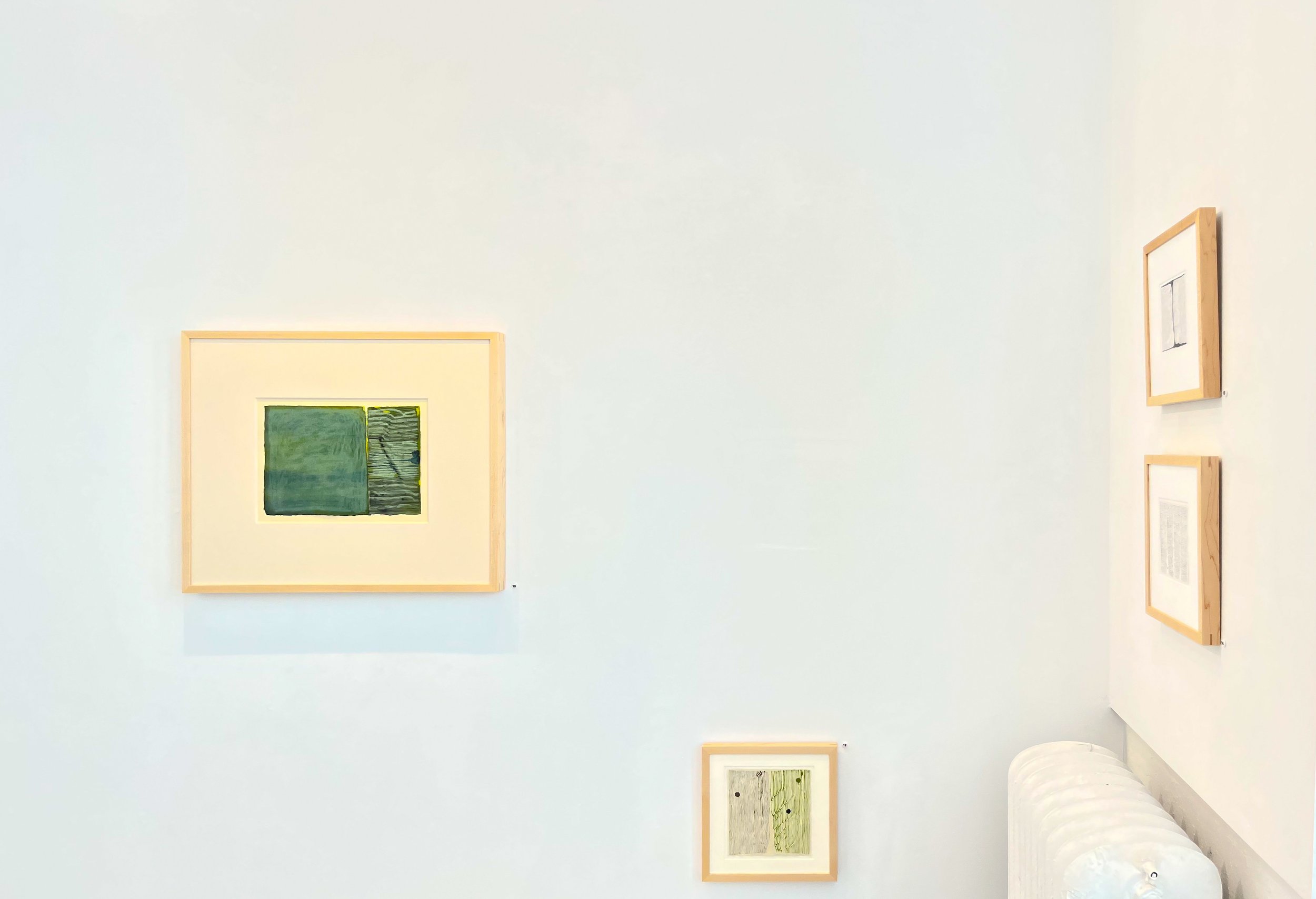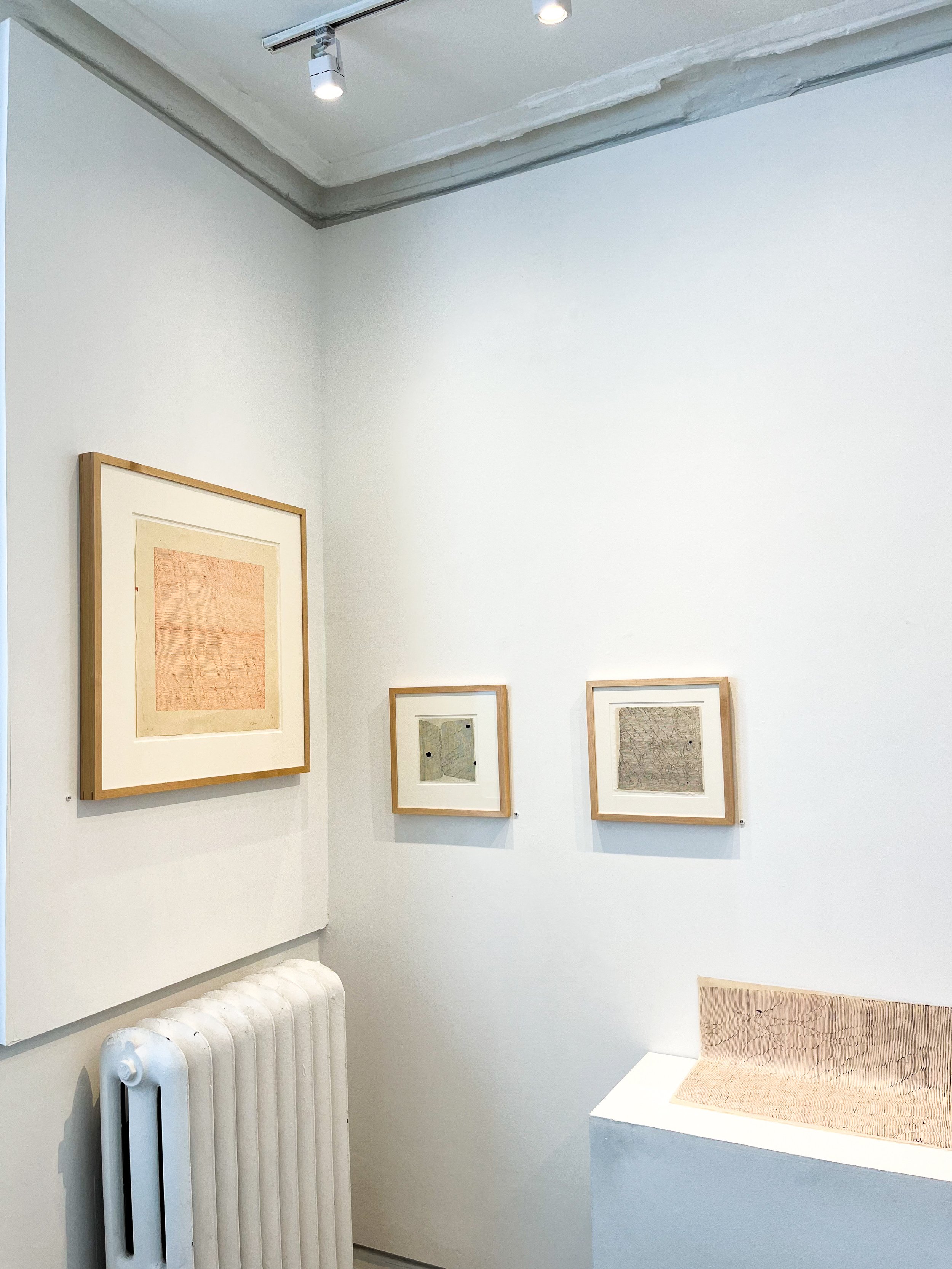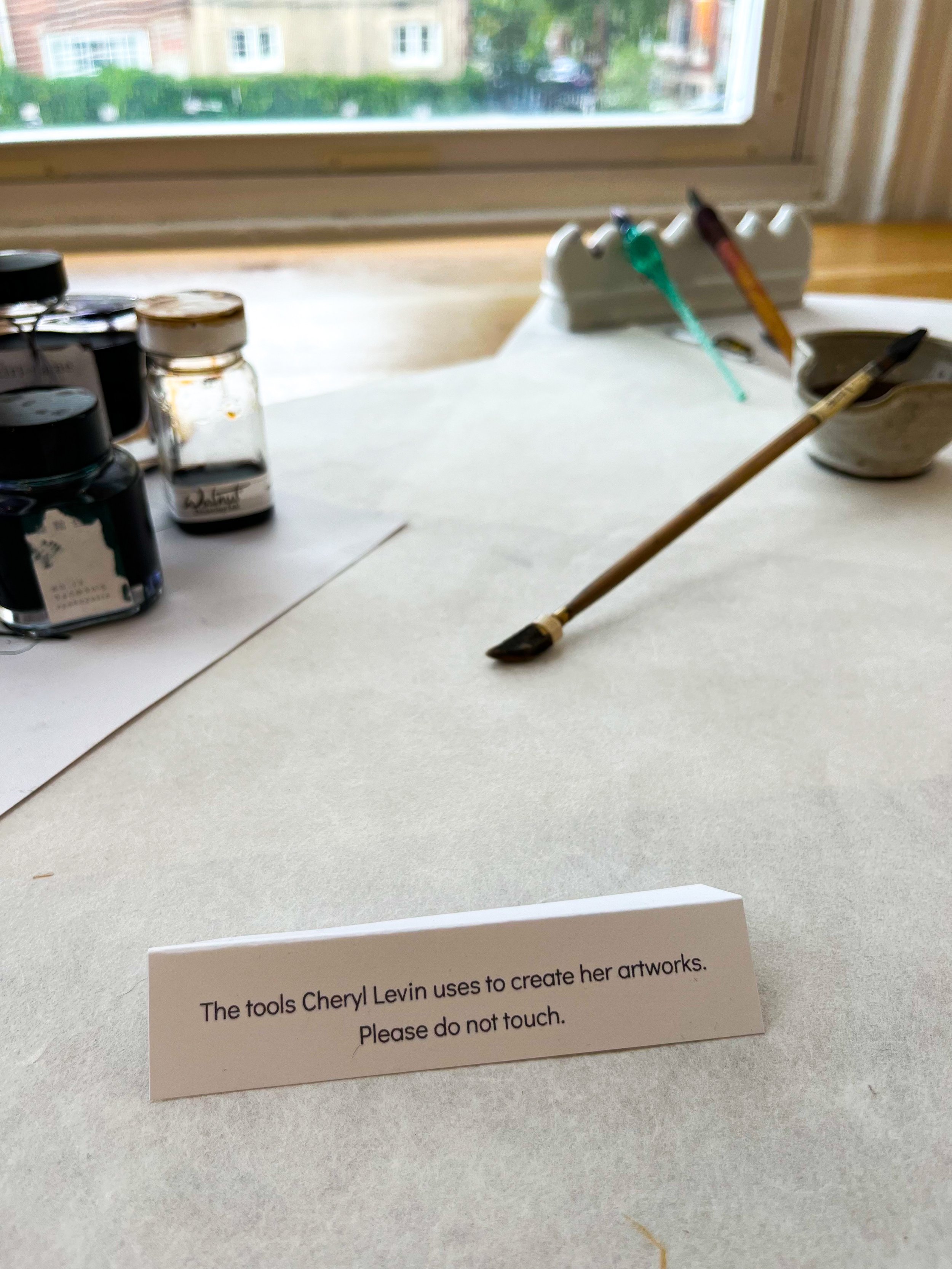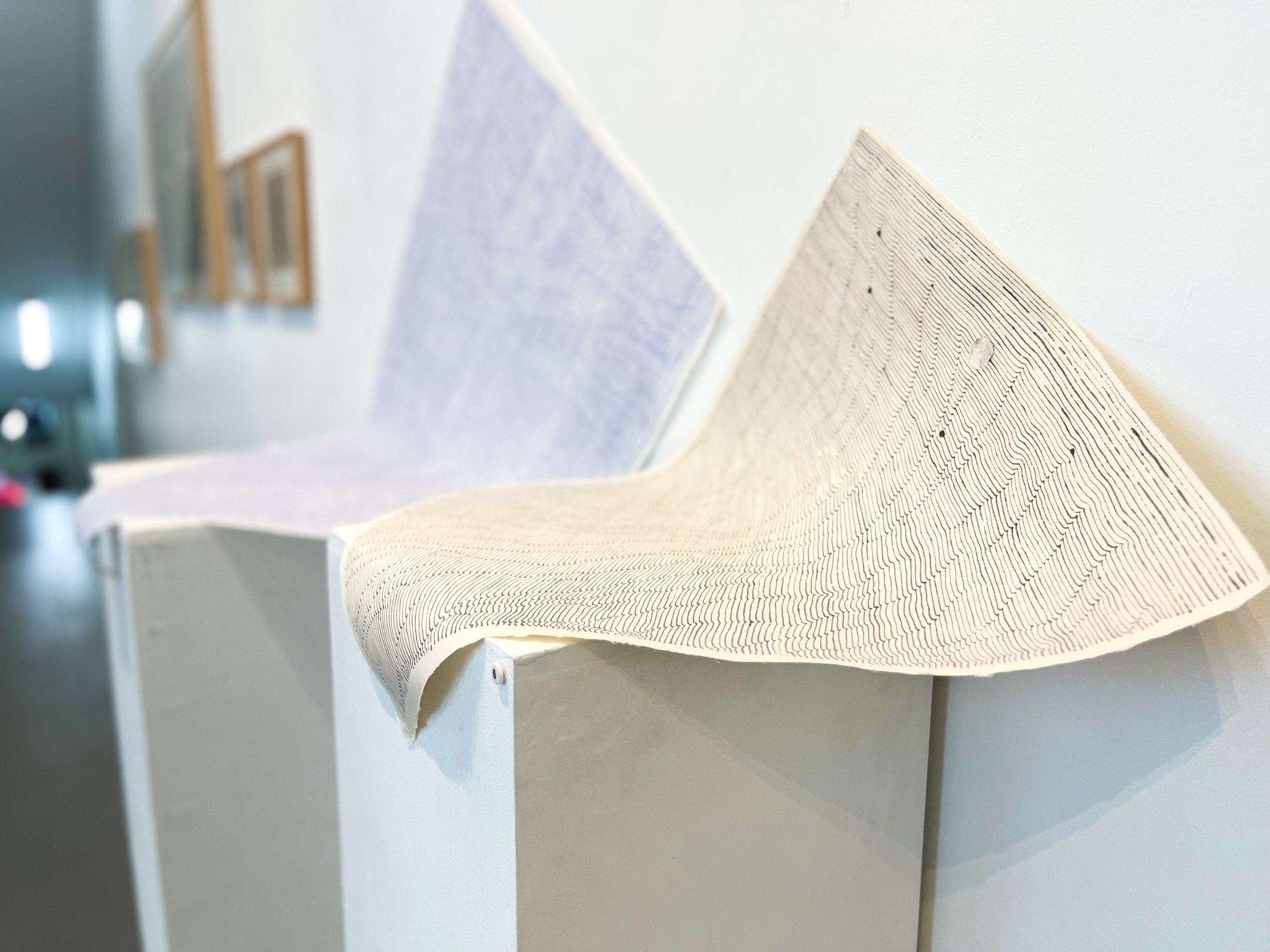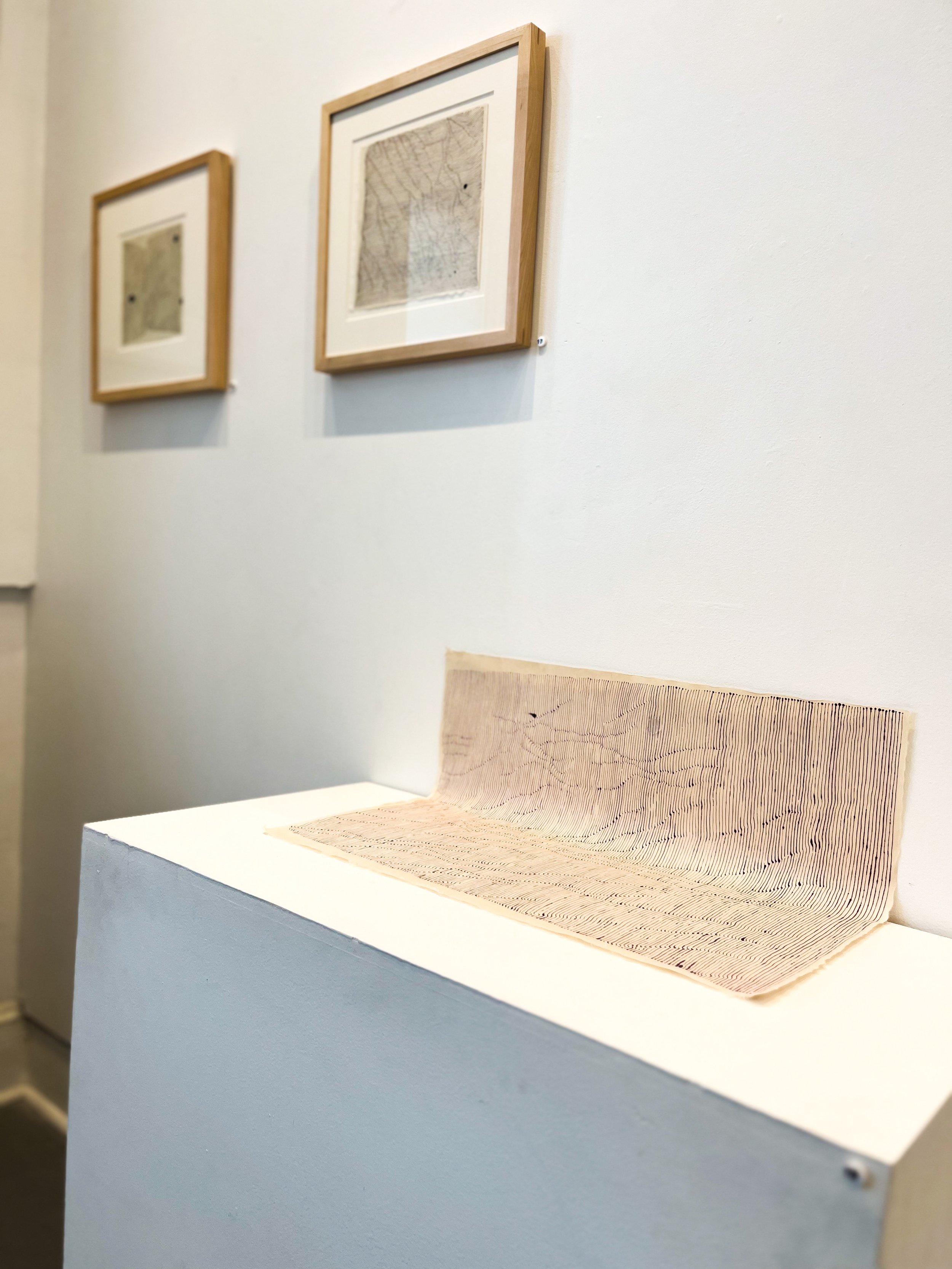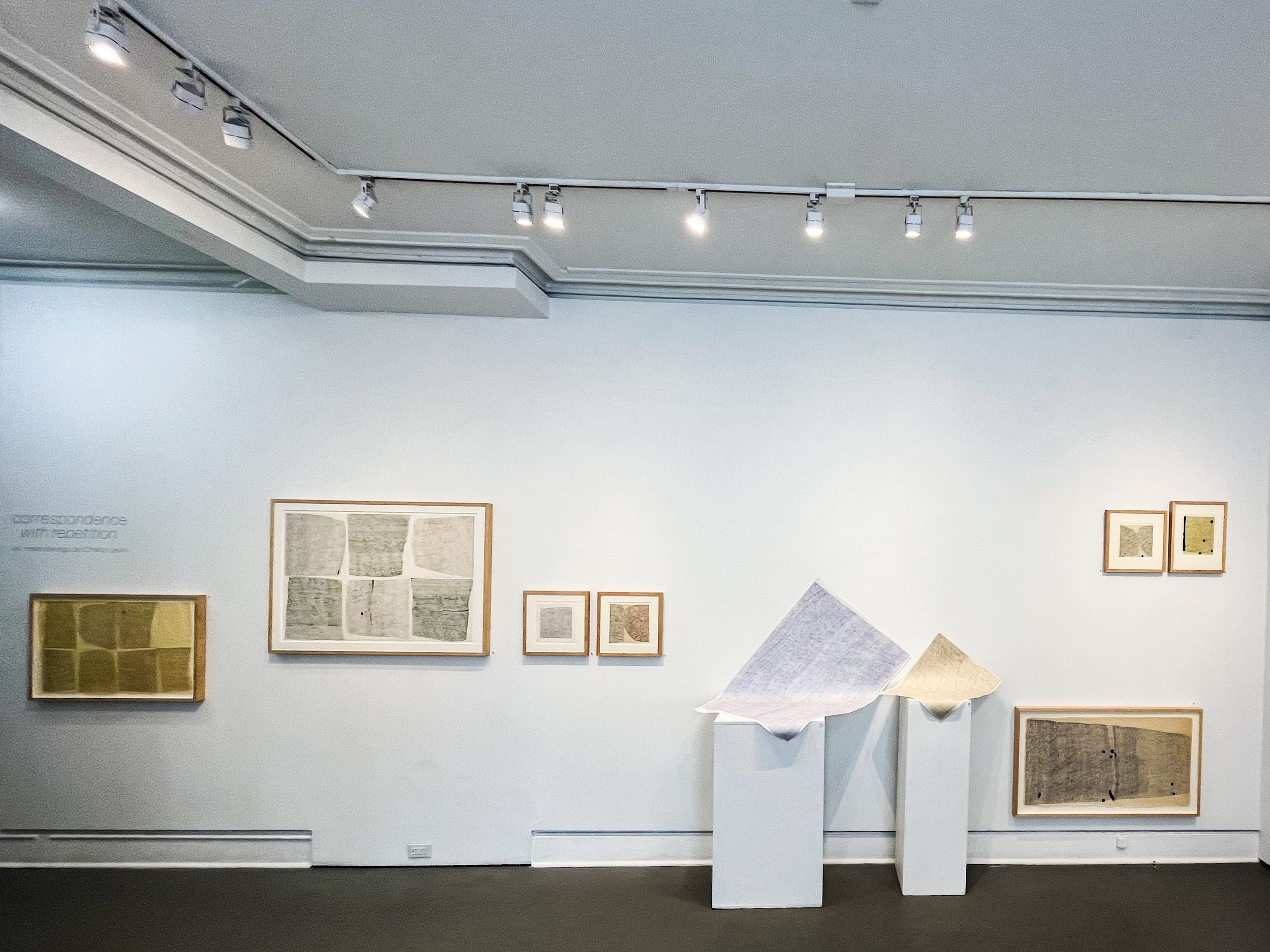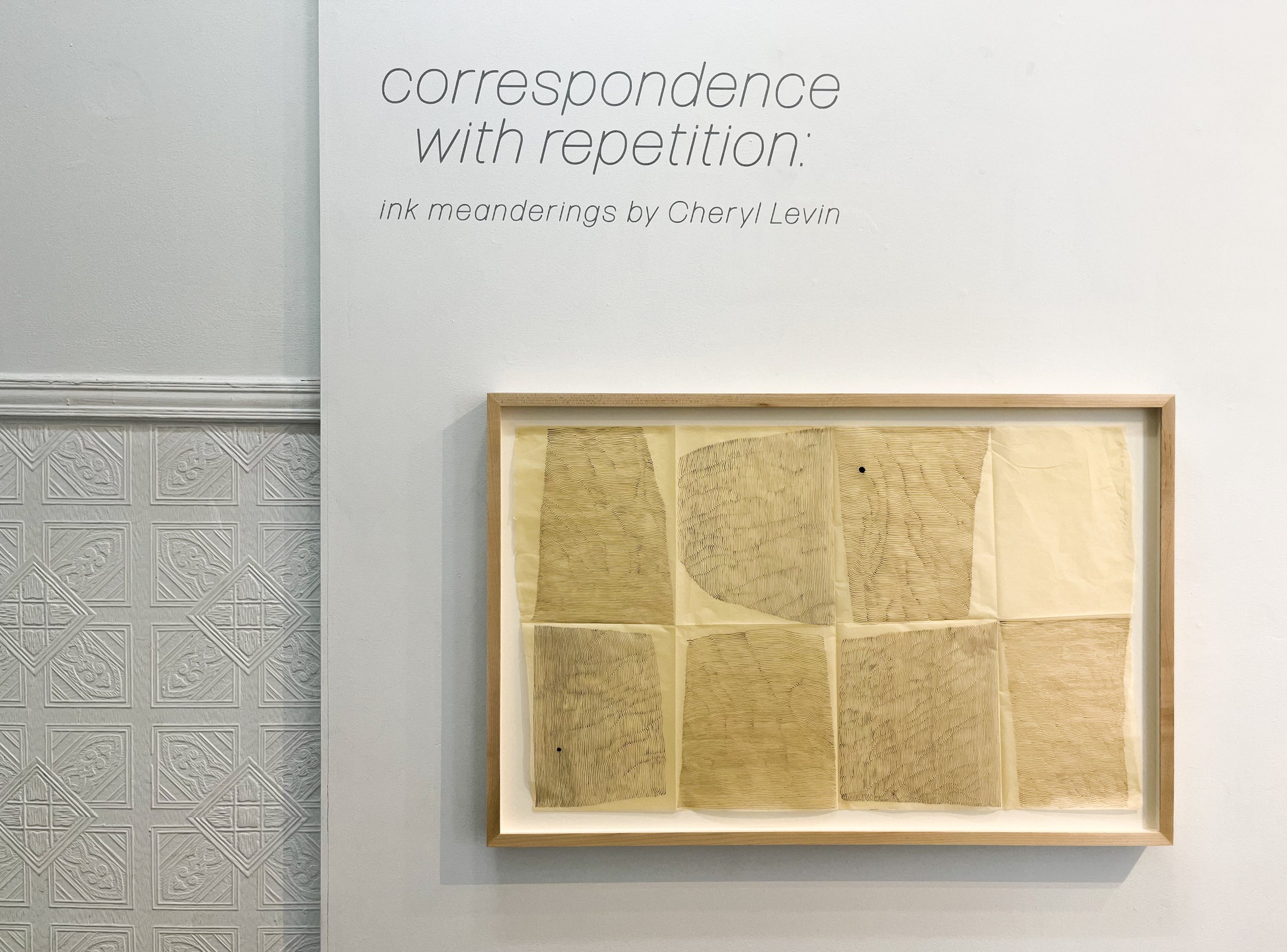AN INTERVIEW BETWEEN CHERYL LEVIN & JULIE YEO: ON LEVIN’S “CORRESPONDENCE WITH REPETITION”
Correspondence with Repetition is a collection of distinct ink meanderings by Cheryl Levin. Placed unconventionally on surfaces “lounging around”, Levin creates an environment where her intricate drawings converse with each other and the viewer.
Correspondence with Repetition is an on-going experimentation of Cheryl Levin’s previous work, “Forms For a Continued Life” which was exhibited at DVAA in 2021. Levin’s approach uses the repetition of line and minimalism as primary to her art practice. Below is an edited interview between Levin and Julie Yeo on her process.
YEO: What is the North Star of your practice?
LEVIN: My North Star? If you mean my inspiration or what makes me want to move my hand across a blank page, that is simply my need to connect with myself in a visual way. When I look at the world, I see shapes colliding – forms and colors – and sometimes I can’t even hear someone talking because I’m too distracted by the light or color shape behind them. This is something I’ve always felt since a young age. But it took a long time for abstract work to become embedded into my practice. And now it makes so much sense. There are no lines in the real world. Planet Earth is not a circle – it is a form spinning in the universe. Planes of real things don’t have a line drawn around them – they collide with something else, or the air, and we see a line where the two forms meet or turn. All of art is an abstraction for that reason, of course. But right now, my North Star is to find ways to communicate a broader sense of feeling using lines, something that doesn’t really exist in life. Maybe my North Star is my line. It grounds me and frees my mind. It gives me a center to work from. Yes, my North Star is my line. But I’m not afraid to lose it or have it change; the work will tell me what I need to do.
YEO: When I first saw your work, I immediately thought of conversation and atmosphere. Now reading your response it makes me think of sound - specifically soundscape or psychological frequency within a field of sound. Do you find your practice is impacted by the atmosphere of different locations, environments?
Levin: “I do listen repeatedly to certain music when I’m working and I’m starting to use parts of the titles of the music I listen to in my titles. I feel a certain way from listening over and over to the same piece of music – it keeps the pace and mood. I’m a pretty sensitive person, so yes, different atmospheres for sure do have affect. Environments that are too noisy or uproarious in a way that I don’t like assault my senses. After those experiences, I’m so grateful to fall back on my practice to re-center. In a way, I’m careful about the input because it may take me a while to recover from some things. I guess everything I do has some effect on the practice. For example, I swim for exercise. In the pool, not only does the repetitive action support my practice, but that watery environment offers a time to reflect in a precise fashion that brings clarity of focus. One of the most memorable places that offered a lasting effect on my art was going to school in Rome. I was smitten with the pictorial information in Italy from the ancient world - Etruscan especially. The manner in which things were displayed – the idea that fragments became important – resonated. You’d have a big wall and then, held up by pins, was a tiny piece of ornament or fresco with irregular edges – the smallest of items gaining importance with all its graceful imperfections. At the heart of this, for me, is the idea of memory, collective or personal – something at the core of my practice. I’ve carried this with me from Rome gratefully all these years.”
YEO: When was the first moment you knew you wanted to be an artist?
LEVIN: One day, my father brought home a How to Draw Book when I was around 8 or 9. Opening the first page, I knew. I progressed through the book and at the end of it was a woman carrying a basket of fruit on her head in a basket. I copied that as expressed in the book. Years later, I started to paint women with children using casein paint on paper in an expressionist fashion, and this image emerged. It took me a while to figure out where that image came from. I also began Saturday art classes at age 12 at a neighborhood place that was in a strip mall, very small with art supplies for sale in the front. It wasn’t an art center. There was a woman in the class who painted detailed pictures – they were abstract designs of some sort. Often when I paint, I think of her – she had long hair and I remember seeing her from the back, quietly painting. I feel in some way – she is/was like an image of a goal I try to reach – her quietness was impressive; she has been a role model. I never spoke to her – I have no idea who she was, but I can see her pictures in my mind and somehow, I’m trying to get to them.
YEO: I am very interested in observing artists while working, but it is not something that gets to happen often. Is there a spark, element, or something that happens within you while making that you hope is visible and memorable to others?
LEVIN: What I hope people find memorable is the sentiments I am trying to convey. I am not about a dramatic image or a grandiose idea of who I am. I’m interested in a fleeting moment and an encounter for the viewer if even for a split second. Because either small or large, a split second is all it takes for someone to want to look again. And if they look again, I would like the viewer to feel a connection to themselves and perhaps a more collective worldview that that life is an abstract idea that we cannot really control.
YEO: If you weren’t an artist, what would have been your alternate career/lifestyle?
LEVIN: Oy! I often think how easy life would be without this burden of wanting to be a picture maker. Not that that statement is true – life is difficult for everyone. But the complications of an art life – well, complicate. When I was younger, I wished I was a firefighter. Many times, I wished I had joined the Peace Corps and worked in some sort of nonprofit – maybe something with a Jewish agency. In high school, I once worked with handicapped children and loved it – if I had some guidance, maybe I would have continued with that. But I had no choice about having an art life; even now, when I think of throwing everything away (which I thought I maybe wanted to do a few years ago), this art life was/is and will be the only choice. So, I can’t really think of a life without art at the center.
YEO: Do you see the mindset that attracts you to that other life in your creative practice?
LEVIN: The mindset, though, that makes me think about throwing everything away, the idea attracting me to a life without art, is seeing how my parents have lived. They’ve been married for 60 years and live very simply. They are happy in their lifestyle. Nothing seems complicated for them. There’s nothing extra in their lives visually. I fight against that – so going against the grain of how I was raised, even though they encouraged me, is a struggle.
YEO: What was your favorite art moment within your lifetime?
It’s happening now. Just recently, I have become aware of the South Korean Dansaekhwa artists, like Park Seo-Bo and Ufan Lee. When I learned about their work, it was truly an 'ahh' moment. Their ideas are the closest thing I have felt to how I want to express myself. They think of themselves as 'encounterers.' In the dictionary, to encounter means 'an unexpected experience or to be faced with something difficult or hostile.' Is art making hostile? For sure – yes, it is also very difficult. I think of myself as an encounterer now, and it changed my perspective in regard to my art practice by really taking in who I am and paying homage to my thought processes. This is what the work has become about – expressing the 'thought patterns' of my daily life and the affective nature of that consideration. Instead of tossing aside my repetitive daily considerations, it has become essential to reckon with my emotions through the encounter of the page. For me, it’s not only about trying to make a successful image, but also about how I can come to a completion of feeling in my being by moving my hand with a tool across a page.
I also will always remember the moments seeing Ellsworth Kelly’s work at The Philadelphia Museum of Art. They have one room of his small black and white paintings. To me, that is all there is to say about art. I’ll also always remember the first time I took my son into that room. My son and I share common artistic tastes. When he felt the impact of Kelly’s work that day, it was like seeing them for the first time through his eyes. It was a great moment. Everything can be summed up in that room. Just a few black shapes against white. But they're not simple, and the paintings’ surfaces speak to me. When I walk into that room, I say 'ahhh'... I am at peace.
YEO: What do you think the next trend will be?
LEVIN: I don't really know. But perhaps more artworks will move in different ways – 3D printing and a continued merging of science and art – robotics – solar-powered sculpture. And I think artists might make more and more art using larger spaces because of technology, and art will be in places it wasn’t before - exterior locations, ceilings, streets. I also think people are very
interested in showing the thought process behind what they are making; the concept behind it becoming visually important – how was it made and why? I also think a whole bunch of young people may want to go back to realism.
YEO: Some people are of the opinion that technology takes us/Art further away from the human hand. But I think technology can also expand the interpretation and definition of what the human hand is. As an artist that has such emphasis on physicality, how do you personally feel about this?
LEVIN: For people who want to use technology, yes, I think it can be an extension of their hand and thinking, but if you’re asking about me personally, my world is the opposite. And although lately, I have been curious to see my drawings enlarged and made to move, I would still need to make them first. And I’m not interested in having a computer do that for me. There is a genre of plotter drawings that began in the 60s that are boss, but that’s not me either. You need a scientific mind for that – you need to be part engineer. My practice involves the touch of paper, the feel of the paper itself, and my hand on it. I’m not just interested in the image itself.
YEO: What advice do you have in keeping the long-term goal of not quitting?
LEVIN: Most people have never stared at a blank page and said to themselves, hey, I want to make a drawing and say something about life today. It’s not an easy thing to do. It’s against the grain of American life. If you’re thinking about how two colors meet and make an edge, for example, it’s nice to be able to discuss that. So, I would say - try to make connections with people who share your values so you can have support. I also think it’s maybe a good idea if you don’t have space to get a studio outside the house and use it. And I’d say no matter how much time you have, just keep things going – the thread over the years will be there for you when you’re ready. There can be inconsistency in the consistent. For me, I think about art all the time; it’s just part of who I am, and although there have been moments where I thought about packing everything up, the truth is I am ungrounded without making art – I would just not be me. So, it’s not a choice. The summation would be then, if it’s not a choice for you, then just keep going in any way you can.
The exhibition will be on view in Gallery 2 at Da Vinci Art Alliance from June 28 - July 23 with an opening reception on Saturday, July 1st from 4-7pm.

